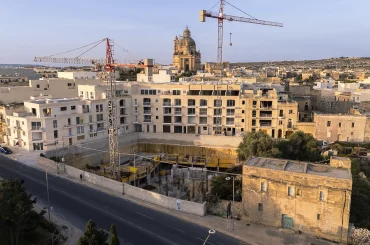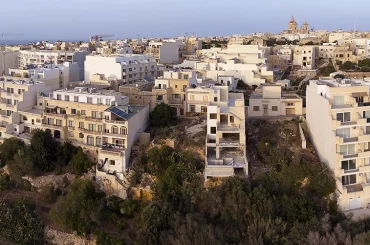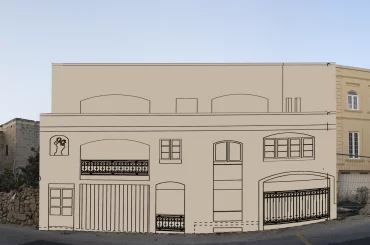Key findings:
- Planning permit regranted to block of flats “as built” despite permit revoked by the court
- Government implemented trio of policy manoeuvres to neuter court revocations of planning permits due to excessive number of floors
- The government quietly removed mention of intensity of development as a planning reason for not exceeding number of floors capped in policy blueprint, the Local Plans
- These changes set to intensify density of development, population density, and congestion
- Yet the policy manoeuvres do not change the law and any permits still run a chance of being revoked if challenged in court
- This creates legal uncertainty for residents as well as developers and investors
- Swimming pools behind buildings at edge of development zones have also been declared illegal by the court
- The court revoked permit for three swimming pools behind buildings in blocks of flats developed by property magnate Joseph Portelli
- Planning Authority has not paid heed to court judgements on swimming pools in new applications
Ten months ago, Chief Justice Mark Chetcuti warned public authorities that ignoring court judgements would be damaging to Malta’s democracy and Malta’s standing internationally. He did not mention specific cases, but he is thought to have been referring to the Planning Authority’s regranting of a planning permit, less than two months earlier, for two penthouses that had been developed by property magnate Joseph Portelli and whose permit had been revoked by the Chief Justice himself presiding over the Court of Appeal.
Despite the Chief Justice’s warning, the Planning Authority in recent weeks sanctioned another block of 29 flats whose permit had been revoked by the Court of Appeal because it had more storeys than permitted in planning rules. The block of flats in Xewkija, developed by Francesco Grima, one of Gozo’s largest developers, had been built by the time the court revoked its permit in November of 2023. Two applications were then put in to sanction the building “as built”.
After processing the applications, the Planning Authority in its Case Officer Report maintained that five floors are permitted at the location – an insistence that defies, or departs from, the court’s reasoning – adding that this has now been “clarified by PA Circular 2/24”. That is a reference to one of the Planning Authority’s policy manoeuvres of 2024 intended to shift the goalposts when it comes to the interpretation of building heights and number of floors.

This appears to be the first time that various policy tweaks implemented in 2024 were deployed to redeliver a permit that had been revoked by the court.
Those policy manoeuvres had in turn been devised in response to court judgments that had revoked planning permits for developments that had more floors than specified in Local Plans. The Local Plans are the core blueprint for planning parameters.

Among several large developments whose permits were revoked by the courts or planning tribunal since 2023 there was the redevelopment of the Dolphin Centre in Hal Balzan into a block of 88 apartments and commercial spaces, and two blocks in Gozo. One of the Gozo blocks consists of 54 flats at Ta’ Zejta and the other of 29 flats in Xewkija mentioned above. The developments in Hal Balzan and Ta’ Zejta belonged to Joseph Portelli and a range of business partners.
Policy changes: a ‘legal fig leaf’ for Planning Authority
An investigation by this journalist can now report that, despite the policy manoeuvres, the detailed policy maps specifying height in floors within the Local Plans remain unchanged and so does the law. And that is something that “reflects a broader tension between policy and law in Malta’s planning system,” says Joseph Mizzi, a lawyer who specialises in property law, including planning appeals, among other things.
In a legal opinion prepared for this investigation, Mizzi writes that instead of “amending the Local Plans through the proper legal process, the government has sought to reframe them through interpretation – a move that introduces legal and procedural uncertainty not only for residents, but also for developers and investors who rely on predictable and enforceable planning rules.”
Article 52 of the Development Planning Act specifies that in case of conflicts between Local Plans and other policies, including supplementary guidance policies such as DC15, the Local Plan takes precedence. In this sense, a tweak in DC15 policy on height in 2024 – one of the policy manoeuvres – has now created such a conflict between Local Plan’s policy maps and DC15.
Another tweak in the interpretation document of Local Plans is intended to bridge the Local Plans and Circular 2/24 mentioned above, and hence lead away from the Local Plans and to the height limitation policies in DC15.
“The newly adopted interpretation is a policy manoeuvre, not a legislative change,” writes Mizzi. “It appears designed to provide the Planning Authority with a legal fig leaf – a justification to continue approving developments that exceed the floor limits set out in the Local Plans.”
On the ground, it amounts to a radical change: the government has now removed any mention of intensity of development, which was previously the point made in the interpretation document to warn of the consequence of greater stacking in number of floors, and hence the importance of adherence to floor limits set in Local Plans.

The government's intention seems to be to remove any constraints on height of buildings and number of floors arising from the Local Plans. This is set to intensify developments of densely stacked floors – the effect will be greater population density and congestion, and infrastructural bottlenecks.
It entrenches what Mizzi describes as “a silent but profound departure from what the Local Plans permitted.”
Alex Torpiano, dean of the Faculty of Built Environment at the University of Malta, said: “The vision is extremely short-sighted. Or rather, there is no vision. This is what worries me. This is also evident in the recently published Vision 2050. For example, on the one hand we want quality tourists but at the same time we project a higher number of tourists.”
Height limitation policy changed by stealth
The road to higher, denser buildings with greater stacking of floors had its tentative beginnings in 2015 with a table that Torpiano and three NGOs (Wirt Ghawdex, Ghawdix and Din L-Art Helwa) are attacking in court, in an ongoing lawsuit, on the basis that it was introduced in its existing form by stealth.
The said policy, P35, and table were published in November of 2015 in DC15 (which is formally called the Development Control Design Policy, Guidance and Standards 2015). The table set height limitations in metres. In the lawsuit, Torpiano and the NGOs have shown evidence that the table was intended to be different than what was published, and that it was intended merely as a “transitory provision” until Local Plans were reviewed.
“The plaintiffs strongly contend,” the lawsuit goes, “that Annex 2 and P35 of DC15 are simply serving as a clandestine and irregular manner to usurp that absolute primacy conveyed on the Local Plans by the principal law.”

“Traditionally, Local Plans set height limits in terms of the number of floors, not metres,” Mizzi writes. “This was a deliberate choice to give communities and regulators a clear visual and spatial sense of permissible development.”
He added that since publication of DC15 the Planning Authority has been “interpreting these floor limits through height measurements in metres” and granting “permits to as many floors as could physically fit within those heights, assuming a minimum internal floor height of 2.6 metres. As a result, areas previously limited to three floors (plus a recessed floor) were, in practice, seeing permits approved for five floors.”
Torpiano said: “In court the Planning Authority is arguing that the overall heights of buildings is not much more than it would have been if the number of floors were set according to the Local Plans and the height of the floors were as before [11 feet high].”
“Our argument is that having a higher number of floors increases density and intensity of development, and this amounts to a wholesale increase in the density of development without carrying out the necessary studies. This has an impact on the community. At least if changes are made through Local Plan review, these changes would have to be based on studies.”
The court case is ongoing.
Court starts revoking planning permits
The law began to catch up with the Planning Authority’s decisions on the number of floors in January of 2023, when the Environment and Planning Review Tribunal, which hears and decides on appeals against planning permits, revoked a permit for a block of 54 flats and 36 garages on the side of Ta Zejta Valley on the outskirts of Rabat, Gozo. This development belonged to the property magnate Joseph Portelli and his partners. The tribunal held that a building at that site had to be limited to three storeys and not five storeys as approved.
The building is now nearing completion – the developer eventually prevailed after a series of subsequent decisions. First, the Court of Appeal revoked the tribunal’s decision on the legal technicality of ultra vires, ruling that the tribunal had gone beyond its powers when it delved into an analysis that went further than the parameters of the appeal. The Planning Authority then granted a new permit, and a further appeal failed after a new tribunal held that the case had become res iudicata (already decided by a court).

The building of five floors now towers over a relatively narrow road that skirts a valley that has been popular with walkers. The road is now becoming busy with motorists bypassing other roads, and it is set to become busier still once the 54 flats are inhabited, further affecting the peacefulness walkers seek in the first place.
In yet another case, in July of 2023 the Court of Appeal reconfirmed the revocation of the permit of a building named Park Lane in Hal Balzan. It was set to be the one of the largest, if not the largest, residential developments in central Malta, consisting of 88 flats and commercial areas including shops. In its judgment, the court was clear: “Additionally this Court cannot but emphasise that a development cannot except for exceptional reasons have more floors than indicated in the local plan for as long as the same plan does not indicate otherwise.”
A few months later the Court of Appeal revoked the block of flats developed by Francesco Grima in Xewkija. In that case the court held there was no conflict between the Local Plan and DC15 on height: that the Local Plan defined the height in number of floors and DC15 set the height limitation in metres within the number of floors set in the Local Plan.
Yet, as already pointed out, the Planning Authority has now sanctioned the block of flats “as built” – the building had already been built when the court revoked the permit – and, in a nod to the court decision, slapped the developer a fine. (It seems somehow odd or contradictory that the Planning Authority maintained that five floors are allowed, hence taking a line contrary to the court’s decision, but at the same time fining the developer before sanctioning the building “as built.”)

High government official denigrates the court and NGOs
The initial government response to the court’s revocation of permits can be found in an article published in the newspaper Malta Today last September. The article reported on an unnamed “high ranking government official” having talked about discrimination affecting well-known developers, insinuating that some NGOs were being weaponised by commercial interests, and then took to faulting the court. The Malta Today article was based on an article in Gozo Today, a newspaper produced for the Ministry of Gozo by the same publishing house that publishes Malta Today.

The official reportedly told Gozo Today that “the courts are deciding that the Local Plans, which are nearly 20 years old, should outweigh more recent policies that are intended to reflect today’s urban planning requirements.”
As already pointed out, it is the law that gives the Local Plans primacy.
The official then pointed out that some projects go ahead and others are having their permits revoked by the court. He “hinted at a growing perception that some NGOs might be weaponized by competing commercial interests to obstruct developments.”
He also claimed that the situation – of the court revoking permits of developments – was creating inconsistency in heights of buildings along the same streets.
The official then lamented the “confusion” and “discrimination” – that well-known developers are more likely to attract objections and legal challenges. The official argued that, in the prose used by the newspaper, the “stark contrast in how projects are treated has ignited debates about the fairness and effectiveness of the current system.”
Instead of ensuring that Planning Authority decisions became aligned with decisions of the Court of Appeal, and the law is upheld, the government proceeded – as the anonymous high-ranking official said – to carry out a trio of policy manoeuvres to overcome the court decisions based on law.
Some of the same lines of reasoning also appear in the official planning document that set out the review of policy P35 – the policy on heights – in DC15 a month later, in October of 2024.
The official said: “An uneven playing field has also been created when cases which make their way to the courts (when planning disputes arise) are having their overall heights reduced [sic] when other neighbouring properties, which are not objected to, proceed to construct the number of levels as originally approved [sic] ultimately result in the incongruous streetscapes which the judicial process is supposedly attempting to prevent.”
Coordinated policy tweaks change nothing
So instead of moving to ensure that Planning Authority decisions became aligned with decisions of the Court of Appeal, and the law is upheld, the government proceeded – as the anonymous high-ranking official had said in the article – to carry out a trio of policy manoeuvres to overcome court decisions based on law.
The first was a review of the policy in DC15 on heights to specify the number of floors that would be allowed (this number being higher than imposed in the Local Plans, despite Local Plans having primacy in law).
The second manoeuvre was Circular 2/24 that lists the height limitation in metres for different zones in line with DC15.
And the third was an amendment in the interpretation document of the Local Plans to refer to Circular 2/24 when it comes to height limitation.
These changes have led to the Planning Authority and the Environment and Planning Review Tribunal to give short shrift to any arguments about the number of floors in the Local Plans.
“We have yet to test the issue of primacy of the Local Plan in court since the latest policy changes of last year, but at the level of the planning boards and planning tribunal, they are no longer receptive to arguments on limits of number of floors set in the Local Plan,” said Alex Torpiano, the dean of the Faculty of Built Environment who is also a council member of the heritage-protection NGO Din L-Art Helwa. “So we do not mention the height limitation in number of floors, and instead we emphasise other policy breaches now in our objections.”
Asked if he thinks the policy changes are legal, Torpiano said: “From the legal point of view, I think Local Plans are still supreme, so nothing seems to have changed. But then I ask, so why did they do these policy changes? Simply because they hope that no one challenges this and things will carry on as they wish? Are they daft? Or is there something we are not seeing?”
The analysis carried out for this investigation suggests that the government may have taken a leaf out of the judgment of the Court of Appeal in the case of the revoked development in Hal Balzan, to conjure a reinterpretation of building heights and floor limits by changing the relevant interpretation section of the Local Plan. But the linkage – or the proverbial bridge – from the interpretation section to the Circular and DC15 is a superficial patch-up. The specific height policy maps in the Local Plans remain unchanged, showing limits in number of floors for every location, and these maps hold the greater weight of detail and specificity.
Penthouses and pools: more permits revoked
The Court of Appeal also revoked other permits in 2023 whenever granted on the back of policies that conflicted with the Local Plan. In two cases the court revoked the upper floors – a row of penthouses – of two blocks of flats belonging to Joseph Portelli and his partners at the edge of Sannat near Ta’ Cenc. The revocation was over insufficient recessing of the top floor as per stipulation in the Local Plan. These judgements served to highlight the clash between the Local Plans and other policies, including guidance provided by the Executive Council of the Planning Authority.
An Indian individual who reportedly works for one of the developers then applied to get a permit regranted for two of the penthouses. The Planning Authority reissued the permits under the so-called summary procedure – a procedure in which certain classes of small, internal developments are granted a permit directly by the case officer, without going to board and public hearings.
No mention was made in the Case Officer Report that an earlier permit granted for the penthouses had been revoked by the Court of Appeal.
The NGO Din L-Art Helwa, whose legal challenge had led to the revocation of the permits in the first place, then filed new proceedings for revocation of the permit in front of the Planning Authority. Last month, the authority’s Planning Board rejected the NGOs request, a decision that has caused further confusion about policies and their interpretation, especially in places where policies or zoning are changed partially.
It was several weeks after the permit was regranted in this case that the Chief Justice warned of the consequences for Malta’s democracy and rule of law if court decisions are ignored by “public authorities.”
Public authorities ignoring court decisions are seen as a violation of the fundamental right to fair hearing (Article 6) by the European Court of Human Rights.
Applications for sanctioning of the other flats in the same buildings whose permits have been revoked have since been put in and are pending.

The Court of Appeal also revoked permits for two swimming pools at the back of the two developments. These pools fell beyond the development zone. In its reasoning, the court referred to the fact that the pools are separated from the buildings by a public footpath. It also made it clear that swimming pools behind buildings falling beyond the development zone could only be given a permit if the pool is sited within the “curtilage” of an existing building with a valid permit or that has existed since before 1978.
That is the requirement of Policy 6.4 of the Rural Policy and Design Guidance, published in 2014. But here once again, for the past 10 years, the Planning Authority has been regularly granting permits for swimming pools that fall beyond development lines at the back of new buildings – decisions that pervert the requirements of the policy.
Eventually the Court of Appeal caught up with this practice and, last year, revoked permits for three swimming pools, including the two mentioned above, in developments belonging to Joseph Portelli and his partners.

Now the developers in the case of the Sannat developments have applied to change the “pedestrian footpath”, which leads from one road to another, to a “proposed area for private open space”, as per architectural drawing put in with the application. The application is pending. Meanwhile the pools have been kept filled and clean, supposedly ready for use.
It also appears that the Planning Authority is prepared to continue to grant permits for similar pools despite these consistent court judgements. One such case was decided in April 2025. In an application for a block of flats on land that belongs or used to belong until recently to Ghasri’s mayor Daniel Attard, the Case Officer Report did not object to two pools in the Outside Development Zone (ODZ) behind the block of flats. The Case Officer Report asserted: “The proposed pool and decking areas each have an approximate area of 75 square metres as required in policy 6.4 of the Rural Policy and Design Guidance, 2014.”
No mention was made of the judgements of the Court of Appeal that revoked permits for pools in similar instances. Only when an objector – the author of this article – made reference to the Court of Appeal’s judgments did the applicant remove the swimming pools outback from the architectural drawings.
Has anything changed legally?
Whether it is the number of floors or swimming pools in Outside Development Zone, the pattern that emerges is of a Planning Authority taking decisions in breach of planning laws. And when the court starts revoking planning permits, the Planning Authority either ignores the court judgment or shifts the policy goalposts.
And where does this leave us legally?
Mizzi argues in his legal opinion, when discussing issues of number of floors, that the “the precedents [court decisions] indicate that any permit granted under the new interpretation – if it allows more floors than the maps in the Local Plan specify – may still be found to breach planning law if challenged.”
“The consequence,” he writes, “is a widening gap between what is done in practice and what the law prescribes – a situation that creates legal uncertainty for all stakeholders.”
Read Joseph Mizzi's entire legal opinion by clicking on this link.
This article was supported by S-Info and funded by the European Union. Views and opinions expressed are however those of the author only and do not necessarily reflect those of the European Union or the European Education and Culture Executive Agency (EACEA). Neither the European Union nor EACEA can be held responsible for them.
The environmental NGO Flimkien Ghal Ambjent Ahjar collaborated with the author on the S-Info project.






